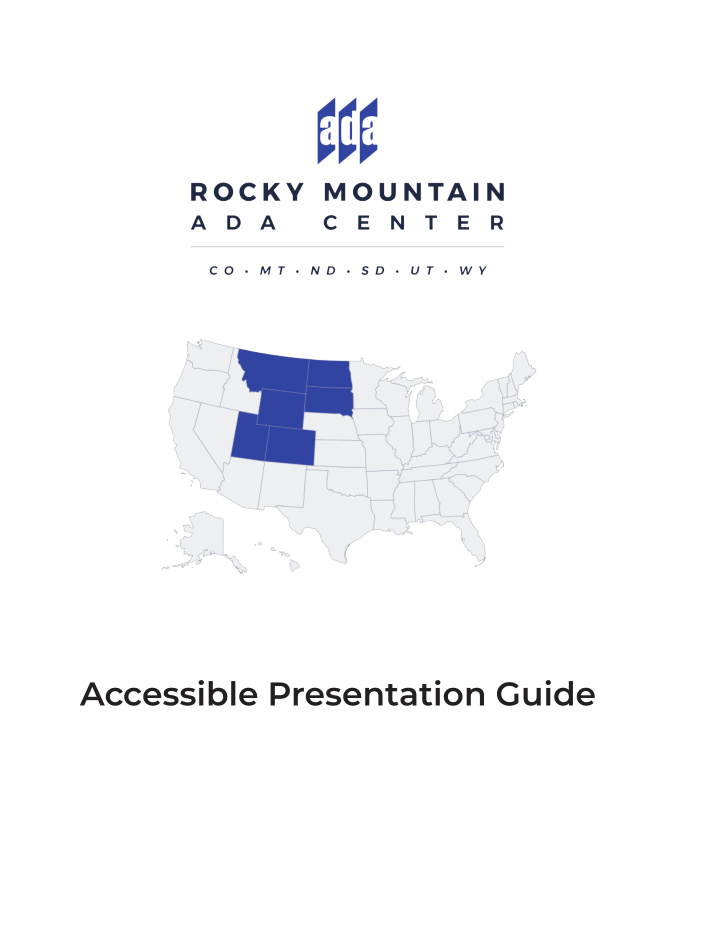



Accessible Presentation Guide
Accessible Presentation Guide Text Aa Have a descriptive and informative page title 18pt � san-serif Use a san-serif font when possible for readability � � Large text - at least 18 point (24px) or 14 point(18.66px) and bold Contrast ratio of at least 4.5:1 for normal text and 3:1 for large text � (Use https://webaim.org/resources/contrastchecker/ ) Images of text - if the same visual presentation can be made using text alone, an image is � not used to present that text. Images of text used for only decoration Blocks of text - over one sentence in length � � no more than 80 characters �not fully justified � line spacing = 1/2 the height of text paragraph spacing= 1.5 times the line spacing �have a specified foreground and background color A more understandable alternative is provided for content that is more advanced than can � be reasonably read by a person with roughly 9 years of primary education Be careful using all CAPS, all CAPS can be difficult to read and can be read incorrectly by � screen readers Colors and Contrast Do not use color as the only way to convey meaning � � Provide good contrast being especially careful with light shades of gray, orange, and yellow A contrast ratio of at least 3:1 is present for differentiating graphical objects such as icons � and components of charts or graphs (Use https://webaim.org/resources/contrastchecker/ )
Accessible Presentation Guide Media - Images/Video If you have embedded video, ensure it is captioned � If you have embedded audio, include a transcript � � If your slides contain animations, ensure they are brief and do not distract from the most important content on the page All images have equivalent alternative text � Strongly recommend a text transcript for all multimedia content � Slide Layouts Use slide layouts provided within PowerPoint to ensure files have correctly structured headings and lists, and proper reading order. 1. Select Home > New Slide, then choose a layout from the drop-down. 2. To change a slide layout, select Home > Layout, then choose a layout from the drop-down. *Use simple slide transitions and avoid automatic slide transitions
Accessible Presentation Guide Slide Reading Order If you Insert other content (e.g, a text box) it will be read by a screen reader in the order � it is added to the page. To check or fix reading order, select Home > Arrange > Selection Pane. Reading order � is shown in reverse, bottom to top. Click and drag or use the arrow buttons to change reading order Alternative Text Images should be given appropriate alternative text in PowerPoint. This alt text is read by a screen reader in a PowerPoint file and should remain intact when exporting to HTML or PDF. 1. Right-click on the image and choose Format Picture. 2. Select the Size & Properties icon and choose Alt Text. 3. Enter appropriate alt text only in the Description field (not the Title field). Data Tables � Accessible tables need a clear table structure and table headers to help guide a screen reader user � Select the Insert tab on the ribbon, then select Table > Insert Table � Keep tables simple. There is no way to add table header information in a way that will be identified by a screen reader � If you have Adobe Acrobat Pro (not just the free Reader), save your presentation to PDF and add table headers in Acrobat Pro
Accessible Presentation Guide Hyperlinks PowerPoint automatically creates a hyperlink when a user pastes a full URL onto a slide and presses Enter or Space. These may not make sense to screen reader users or others, so make the link text descriptive. 1. Select a hyperlink, right click, and select Edit Hyperlink or hit Ctrl + k. 2. Change the text in the Text to Display field to a more meaningful description. Accessibility Checker 1. Select File > Info. 2. Select the Check for Issues button and choose Check Accessibility. 3. The Accessibility Checker task pane will show accessibility errors, warnings, and tips on how to repair the errors. *Do not put accessibility information like alternative text in the Notes pane Select specific issues to see Additional Information at the bottom of the pane.
Recommend
More recommend